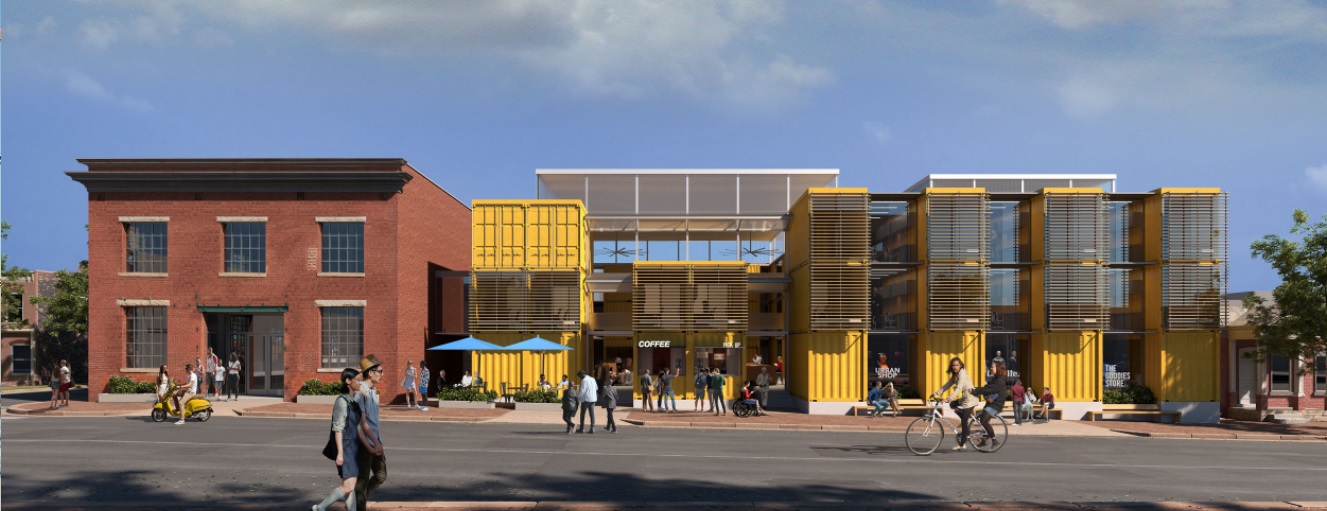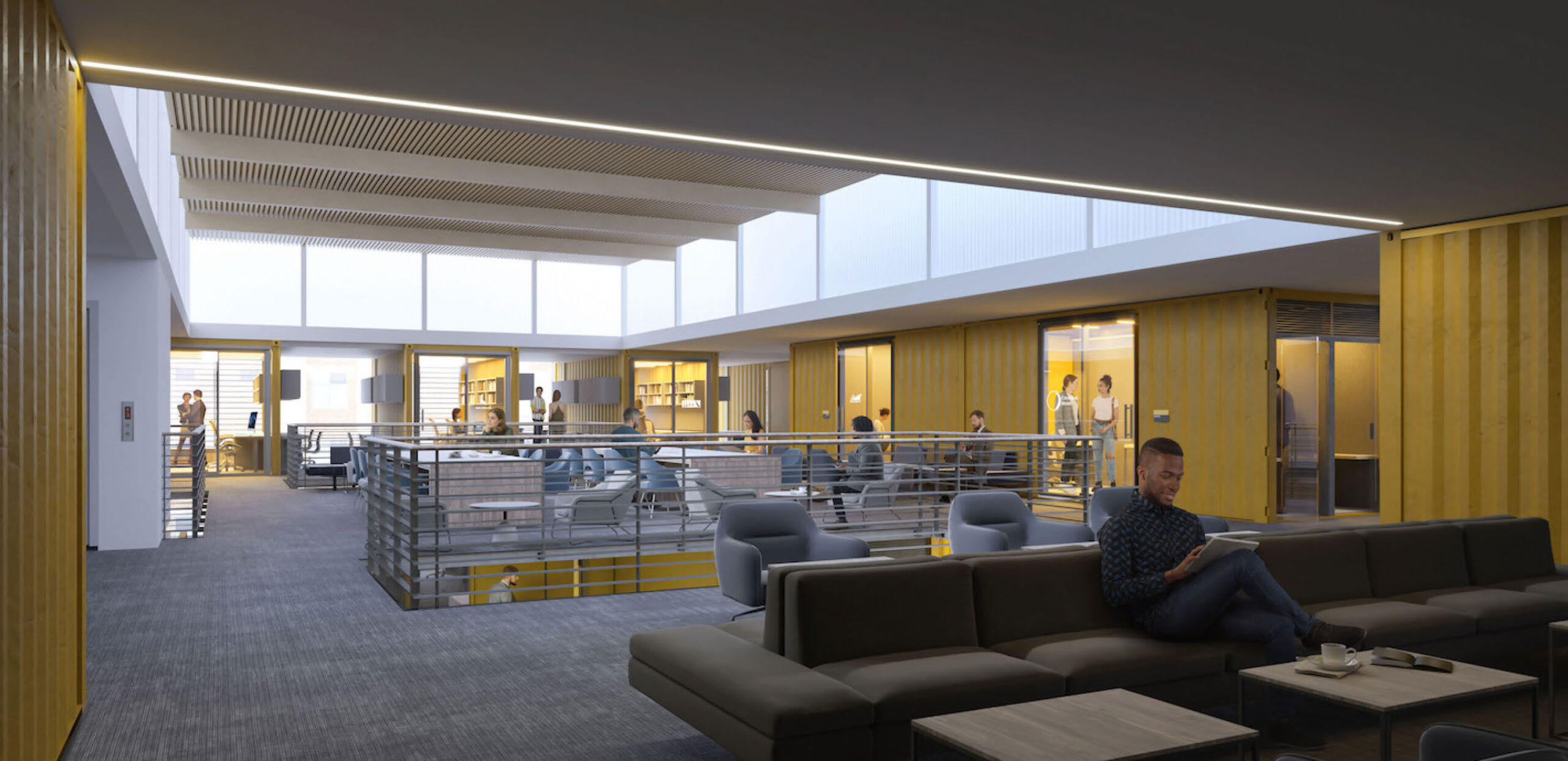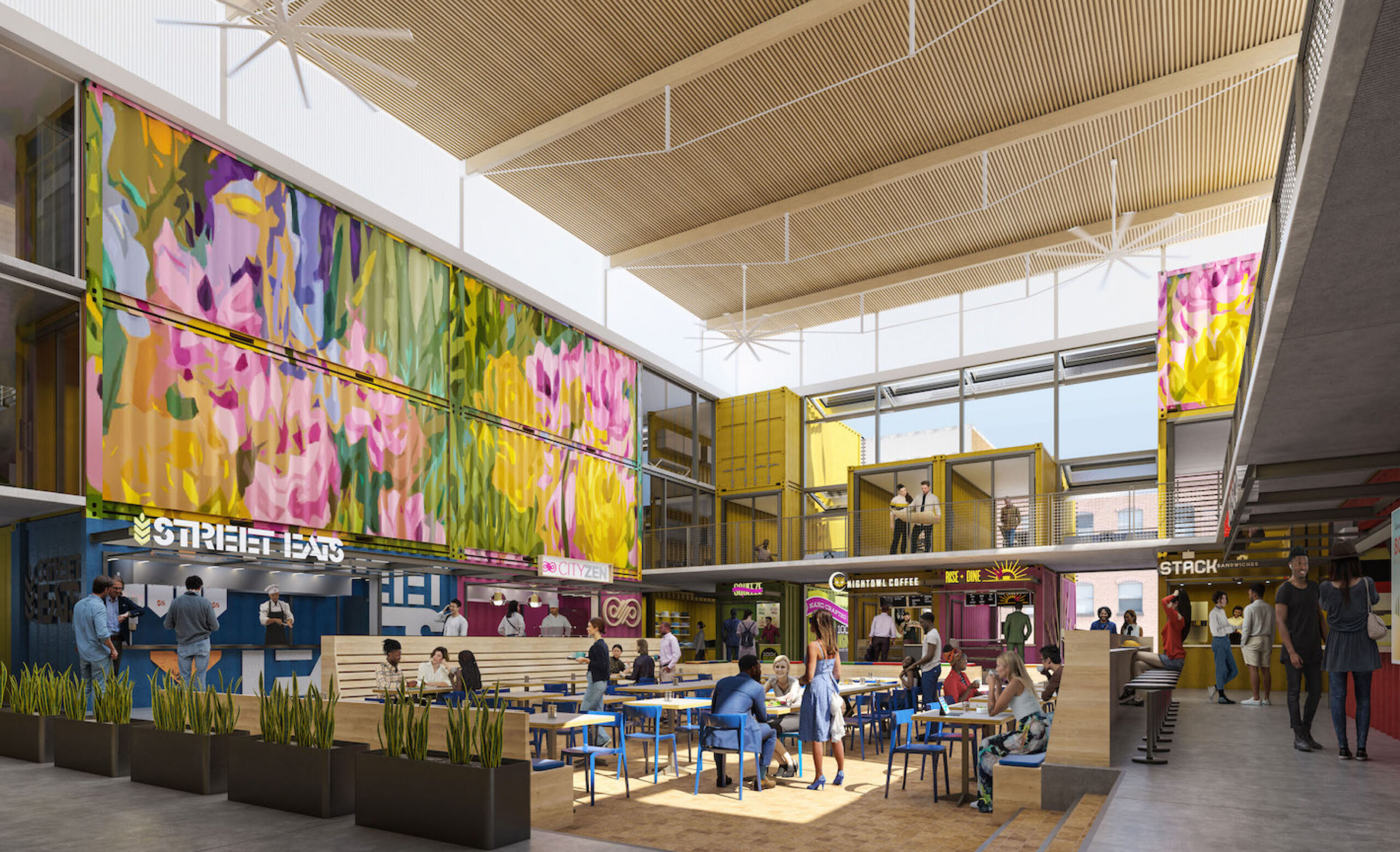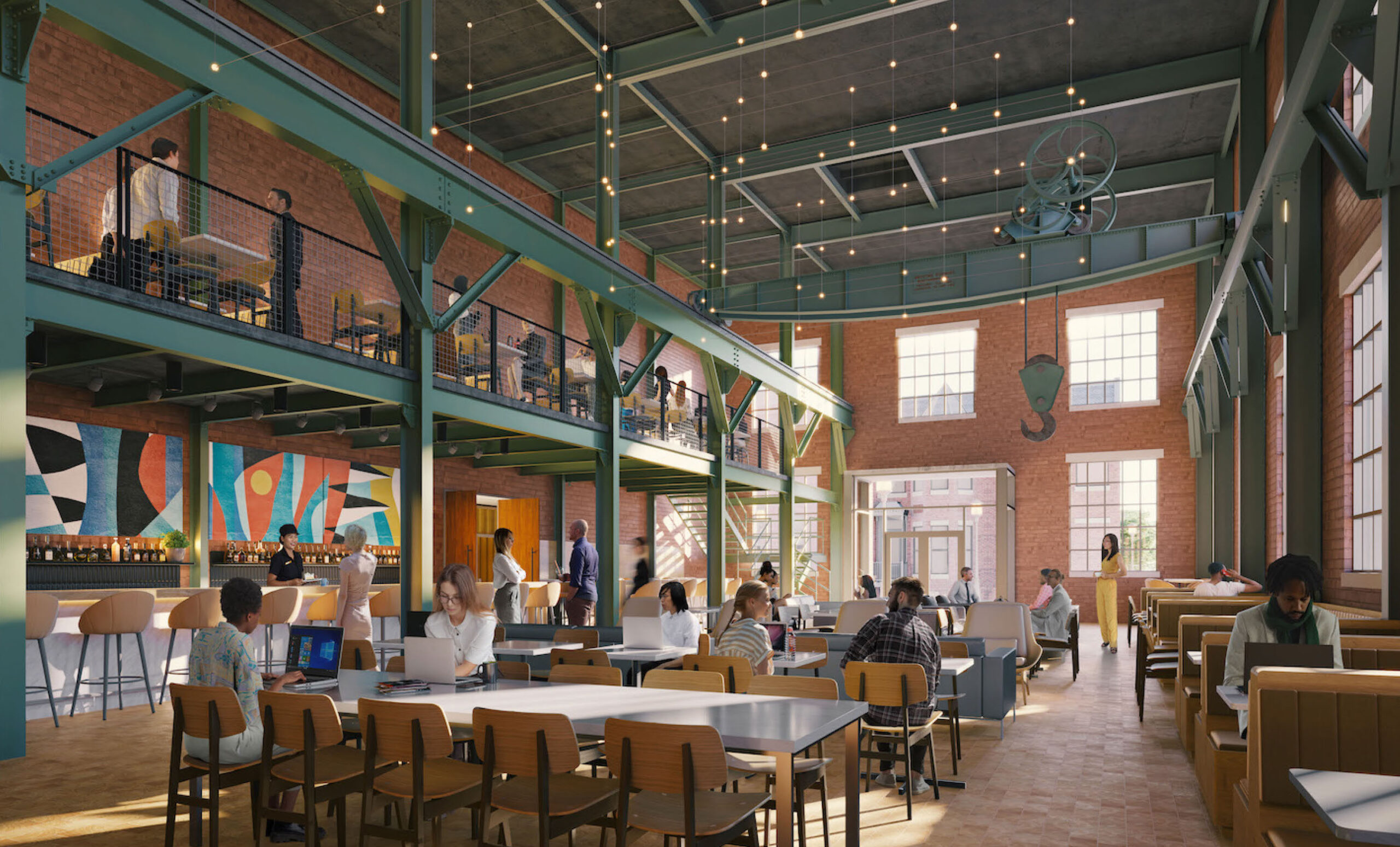
A rendering of Carver Station as it would appear along Clay Street. It would be built in part out of reused shipping containers. (Images courtesy of Future Cities)
A plan to convert an old power substation in Carver into a mixed-use neighborhood hub is progressing.
Developers behind the project unveiled designs over the weekend for what they’re now calling Carver Station, a planned rehab and conversion of the century-old building and adjoining yard at Clay and Harrison streets into a food hall, gathering room and coworking-office space built in part out of reused shipping containers.
The plans, which were shared at a community meeting Saturday and are posted on a website for the project, show the two-story building reborn as a food-and-beverage-style space that would serve as a community lounge by day and a small-plate restaurant and wine bar by night.
The rest of the property would be filled with new construction that would house coworking spaces and “micro-offices,” including office “pods” made from upcycled shipping containers. The new construction would rise as high as three stories above the yard.
The project is led by Michael Hallmark, who along with business partner Susan Eastridge is behind the arena-anchored GreenCity project in Henrico and an office development planned to replace the Public Safety Building downtown. An entity tied to Eastridge’s Fairfax-based Concord Eastridge firm purchased the half-acre Carver Station site last year for $1.6 million.
Hallmark, who resides in Carver, is driving the concept for Carver Station with his Future Cities firm, which includes collaborator Sean Duncan and recent addition Jordan Greene, a VCU alum and interior designer who is serving as the project’s development manager.
Architecturefirm is designing the project, and W.M. Jordan Co. was lined up as the contractor.
The group is preparing applications for a special use permit that would be needed from the city for the project to go forward. In a release, the group said the applications would be submitted in the next week or two, with Roth Jackson attorney Mark Kronenthal providing representation.
The group is designing the project based on feedback from the Carver Area Civic Improvement League and seeking further input from area residents and businesses. It’s also working with marketing firm Rocket Pop on branding and local programming for the project.
Designs show the wine bar would be tucked under the mezzanine of what’s being called the “Crane Room,” referring to the overhead steel-beam crane system that remains operational and is to be preserved as part of the project.
The room would also be able to accommodate community meetings and events. Bricked-in windows on the building’s ground floor would be reopened, and skylights would be placed back on the roof.
The adjacent food hall and market would consist of about a dozen food-and-beverage user spaces, along with spaces for retail vendors. Tenants for those spaces have yet to be selected.

Coworking and office spaces would fill the second and third floors of the shipping containers structure.
The office spaces would be located on the second and third levels of the new construction. The coworking space would use a membership model with different fees for container pods, reserved desks with lockable storage or floating access to all work and common areas.
The project also is planned to involve features such as rooftop solar and rainwater harvesting for reuse on site.
Formerly a substation for Dominion Energy, the decommissioned property dates to 1910 and is listed on the National Register of Historic Places as one of a dozen that make up the Carver Industrial Historic District, making the project eligible for historic preservation tax credits. Hallmark has said a construction budget for the project has not been finalized.
Pending city approvals, construction is anticipated in the first quarter of 2023 with a 12- to 14-month buildout.

A rendering of Carver Station as it would appear along Clay Street. It would be built in part out of reused shipping containers. (Images courtesy of Future Cities)
A plan to convert an old power substation in Carver into a mixed-use neighborhood hub is progressing.
Developers behind the project unveiled designs over the weekend for what they’re now calling Carver Station, a planned rehab and conversion of the century-old building and adjoining yard at Clay and Harrison streets into a food hall, gathering room and coworking-office space built in part out of reused shipping containers.
The plans, which were shared at a community meeting Saturday and are posted on a website for the project, show the two-story building reborn as a food-and-beverage-style space that would serve as a community lounge by day and a small-plate restaurant and wine bar by night.
The rest of the property would be filled with new construction that would house coworking spaces and “micro-offices,” including office “pods” made from upcycled shipping containers. The new construction would rise as high as three stories above the yard.
The project is led by Michael Hallmark, who along with business partner Susan Eastridge is behind the arena-anchored GreenCity project in Henrico and an office development planned to replace the Public Safety Building downtown. An entity tied to Eastridge’s Fairfax-based Concord Eastridge firm purchased the half-acre Carver Station site last year for $1.6 million.
Hallmark, who resides in Carver, is driving the concept for Carver Station with his Future Cities firm, which includes collaborator Sean Duncan and recent addition Jordan Greene, a VCU alum and interior designer who is serving as the project’s development manager.
Architecturefirm is designing the project, and W.M. Jordan Co. was lined up as the contractor.
The group is preparing applications for a special use permit that would be needed from the city for the project to go forward. In a release, the group said the applications would be submitted in the next week or two, with Roth Jackson attorney Mark Kronenthal providing representation.
The group is designing the project based on feedback from the Carver Area Civic Improvement League and seeking further input from area residents and businesses. It’s also working with marketing firm Rocket Pop on branding and local programming for the project.
Designs show the wine bar would be tucked under the mezzanine of what’s being called the “Crane Room,” referring to the overhead steel-beam crane system that remains operational and is to be preserved as part of the project.
The room would also be able to accommodate community meetings and events. Bricked-in windows on the building’s ground floor would be reopened, and skylights would be placed back on the roof.
The adjacent food hall and market would consist of about a dozen food-and-beverage user spaces, along with spaces for retail vendors. Tenants for those spaces have yet to be selected.

Coworking and office spaces would fill the second and third floors of the shipping containers structure.
The office spaces would be located on the second and third levels of the new construction. The coworking space would use a membership model with different fees for container pods, reserved desks with lockable storage or floating access to all work and common areas.
The project also is planned to involve features such as rooftop solar and rainwater harvesting for reuse on site.
Formerly a substation for Dominion Energy, the decommissioned property dates to 1910 and is listed on the National Register of Historic Places as one of a dozen that make up the Carver Industrial Historic District, making the project eligible for historic preservation tax credits. Hallmark has said a construction budget for the project has not been finalized.
Pending city approvals, construction is anticipated in the first quarter of 2023 with a 12- to 14-month buildout.


Looks very creative!
Wow, very ambitious! Love it!
They are doing something similar in Pasco, Co. Florida, using shipping containers as the primary structures.
Interesting as DHR won’t generally let individuals put windows on warehouses (Hermitage Road Warehouse District) but might allow stacked shipping containers as office space on a tax credit application?? I don’t remember seeing that in Carver? I do think the design is very creative and welcome use for the old space. Not sure a Wine Bar next to VCU will do well. Wine Bars are closing as Secco and RVA Wine Station have recently closed for good.
The substation was never a “warehouse” per se, while it was industrial. Their proposal would reopen existing windows that had been bricked over. “Wine Bar” may be overemphasizing that program. It would be a full-service bar with plenty of cocktails and craft beers – with a robust wine program.
Jardin and Celladora might take umbrage with this post…
Very creative using shipping containers. I’ve been in containers that have been refurbished for residential use. They were wonderful!
Excellent design.
If they haven’t already, my advice to Danny and Adam is to inform their clients and contractor that they need to purchase the containers YESTERDAY. Containers are at the very forefront of global supply chain issues, and the availability of virgin or gently used containers with a clean chain of custody (i.e. no hazardous storage) are more expensive to procure.